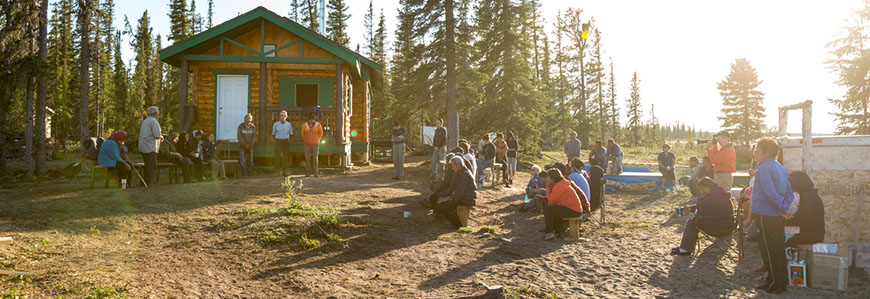
How to get involved
Information for the public, Indigenous peoples and proponents
To find information on an assessment of interest, please see the Canadian Impact Assessment Registry.
Canadian Impact Assessment Registry – Parks Canada projectsPublic
Impact assessment provides an opportunity for you to share your views with Parks Canada on the potential impacts of a proposed project.
For help related to participating in an impact assessment, email: ia-ei@pc.gc.ca
Commenting on assessments under the Impact Assessment Act
For every project-level assessment, a Notice of Intent is posted to the Canadian Impact Assessment Registry for a minimum of 30 days. During this window, you are invited to contact a designated Parks Canada employee. They will record your comments and can provide more project information. All comments are considered and may influence the project evaluation. When the 30-day notice period is over, Parks Canada can conclude the impact assessment. Once the decision on the assessment has been made, it is posted on the Registry. This Notice of Determination states whether the project was found to pose significant adverse environmental effects.
Commenting on assessments in the North
For projects located in a Parks Canada protected heritage place north of the 60th parallel, there are legislated environmental assessment regimes specific to Nunavut, the Mackenzie Valley, the Yukon, and the Inuvialuit settlement region. The process for public participation varies by region. To find out more about the process in the North, refer to the links to the northern review boards on our page about project-level impact assessment in the North.
Additional public participation opportunities
Public consultations
Additional opportunities to participate in the planning of a proposed project or the impact assessment will sometimes be advertised on the homepages of individual Parks Canada protected places. You can also check their social media accounts. Notice of events like town halls will be posted online.
The project’s level of potential risk to the environment and public interest influences the consultation plan. These factors also inform how the public is invited to share their thoughts. For example, Parks Canada may proactively consult with a local mountain biking association about a new trail proposal. If the trail will be adjacent to private properties, local residents may also be consulted.
Commenting on pre-approved routine impact assessments (PRIAs)
Parks Canada also invites comments on its pre-approved routine impact assessments (PRIAs) at anytime. PRIAs exist for routine projects where the potential impacts are well understood. The potential impacts are addressed by suite of tried and true mitigation measures. As such, comments are invited on the PRIA itself, rather than on individual projects.
To view the PRIAs, visit Pre-approved routine impact assessments on Open Government.
Indigenous Peoples
Respecting the rights and interests of Indigenous peoples results in better decisions and supports reconciliation. Through collaboration, Parks Canada and Indigenous peoples are partners in conserving natural and cultural heritage and sharing the stories of these treasured places.
Opportunities for Indigenous engagement
Parks Canada team members at our sites across the country work to create opportunities for meaningful collaboration with Indigenous peoples in impact assessment. Consultation with Indigenous peoples in impact assessment is separate from consultation with the general public. We invite Indigenous groups, according to their interest, to engage in impact assessments. The specific approach to their engagement varies depending on the interests and needs of Indigenous groups.
Contact information is available on the homepage of each Protected Heritage Area. Find links to these homepages on Parks Canada’s map of Protected Heritage Areas:
For help related to participating in consultation, email ia-ei@pc.gc.ca
Proponents (if you have a project proposal)
This information is for those who have a proposal requiring use of land or authorization in a national protected heritage area.
Parks Canada’s impact assessment process is applicable to all projects proposed in national protected heritage areas, including those proposed by external proponents. The process helps ensure compliance with:
- the Impact Assessment Act, 2019
- other applicable federal legislation
- the Parks Canada mandate
- policies that are important for the preservation of these special places.
Parks Canada’s process may be different from what you are used to if you have mostly worked with municipal or provincial approvals. We recommend that external proponents consult the Guide to the Parks Canada Process under the Impact Assessment Act for more information about project review. The guide explains:
- how to develop and submit a project description
- how your project description will be reviewed
- selection of the appropriate pathway of assessment
- other important steps in the IA process
Early initiation and integration of impact assessment is one of our key guiding principles. We highly recommend that you contact the management at the park or site as soon as you have a project concept. We can alert you to any constraints, policy implications and timeline considerations. Generally, it results in a smoother process overall. You can and should reach out before you have detailed project descriptions or engineering design work done.
Contact information is available on the homepage of each Protected Heritage Area. Find links to these homepages on Parks Canada’s map of Protected Heritage Areas:
For help finding the right contact for your project, email ia-ei@pc.gc.ca
- Date modified :